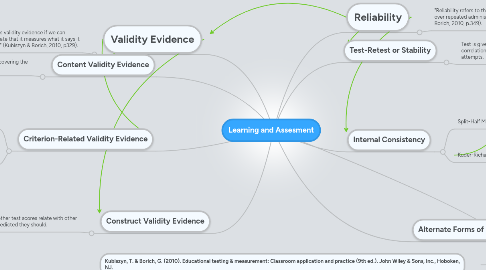Learning and Assesment
by Trisha Hall


1. Validity Evidence
1.1. "A test has validity evidence if we can demonstrate that it measures what it says it measures" (Kubiszyn & Borich, 2010, p329).
2. Content Validity Evidence
2.1. Determines whether the test is covering the correct content and material.
3. Criterion-Related Validity Evidence
3.1. Concurrent criterion-related validity evidence
3.1.1. "Concurrent validity evidence is determined by correlating test scores with a criterion measure collected at the same time" (Kubiszyn & Borich, 2010, p.339).
3.2. Predictive validity evidence
3.2.1. "Predictive validity evidence is determined by correlating test scores with a criterion measure collected after a period of time has passed (Kubiszyn & Borich, 2010, p.340).
4. Construct Validity Evidence
4.1. Evaluates whether test scores relate with other vairables as predicted they should.
5. Kubiszyn, T. & Borich, G. (2010). Educational testing & measurement: Classroom application and practice (9th ed.). John Wiley & Sons, Inc., Hoboken, NJ.
6. Test-Retest or Stability
6.1. Test is given multiple times to find a correlationg between the scores on different attempts.
7. Internal Consistency
7.1. Split-Half Method
7.1.1. "Divides a test into halves and then correlates the halves with one another" (Kubiszyn & Borich, 2010, p.349).
7.2. Kuder-Richardson methods
7.2.1. "Determine the extent to which the entire test represents a single, fairly consisten measure of the concept" (Kubiszyn & Borich, 2010, p.349).
